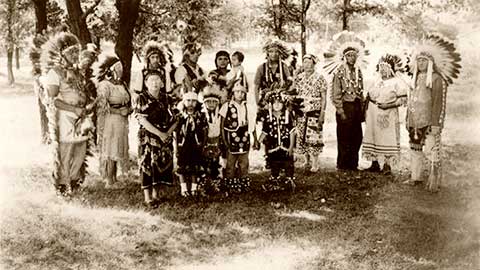Our History
About 500 years ago, as Europeans began settling in North America, the ancestors of the Mille Lacs Band began migrating west from the Atlantic coast of North America to the place “where the food grows on water.” By the mid-1700s, the Ojibwe had established themselves in the region around Mille Lacs Lake in what is today East Central Minnesota. For the Mille Lacs Band of Ojibwe, the move marked the beginning of a 250-year relationship with the region.
The next century saw the white settlement of North America spread further and further west and eventually take most of the lands previously occupied by American Indians. In the Treaty of 1837, our ancestors ceded millions of acres of land in what is now Minnesota and Wisconsin to the United States, but reserved the right to hunt, fish, and gather on the ceded lands. In the Treaty of 1855, the United States government set aside 61,000 acres of land south and west of Mille Lacs Lake, which became the Mille Lacs Band of Ojibwe reservation
For decades after the Treaty of 1855, the Ojibwe people’s hopes of living in peace and preserving their culture and traditions were thwarted as non-Indian settlers continued to move west. By the end of the 19th century the Band was virtually landless, and tribal members were being removed from the home they had occupied for generations.
During this same time, the government declared that Indians must conform to the lifestyles of non-Indians. Mille Lacs Band children were moved to government boarding schools, where, in an attempt to assimilate them into mainstream society, they were forbidden from speaking the Ojibwe language or practicing their religious and cultural teachings. Generations of Ojibwe people were stripped of their identity in an effort to achieve conformity.
Recognition of Self-government
In 1934, Congress passed the Indian Reorganization Act, which formally reaffirmed Indian tribal self-governance and was intended to restore Indian self-determination and tribal culture. But not long after, the United States government adopted the Indian Termination and Indian Relocation policies, which seriously set back the practice of Indian self-government. However, in the 1950s strong leadership provided by Mille Lacs Band of Ojibwe leaders Fred Jones and Jerry Martin courageously laid the groundwork for a modern era of successful tribal government.
As sovereign nations, American Indian tribes establish the laws that govern activities within their reservations. Indian tribes also provide infrastructure to accommodate the health, safety, education, and general welfare needs of tribal members. American Indian Tribes, including the Mille Lacs Band of Ojibwe, have unique relationships with the United States Government as well as the state and local governments in which their reservations are located

